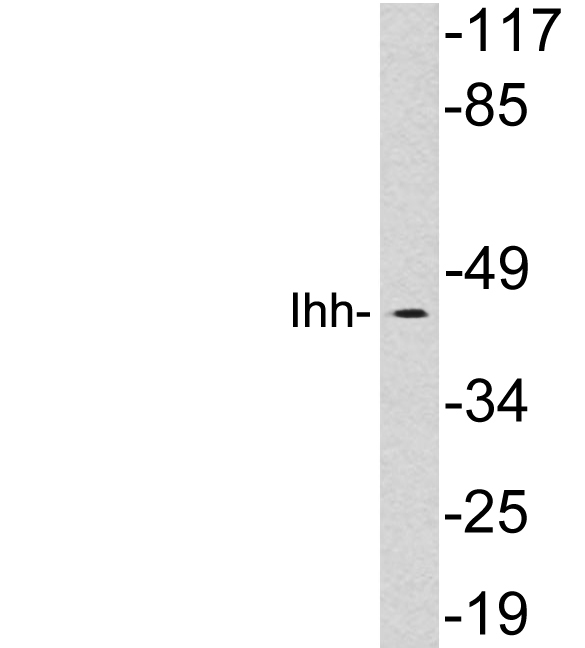- 首页
- 公司介绍
- 热门促销
-
全部产品
-
试剂盒
- |
-
一抗
- |
-
二抗
- |
-
蛋白
- |
-
免疫组化试剂
- |
-
WB 试剂
- PonceauS Staining Solution
- PBST Washing Buffer, 10X
- 1.5M Tris-HCl Buffer, pH8.8
- 1M Tris-HCl Buffer, pH6.8
- 10% SDS Solution
- Prestained Protein Marker
- TBST Washing Buffer, 10X
- SDS PAGE Loading Buffer, 5X
- Stripping Buffered Solution
- Tris Buffer, pH7.4, 10X
- Total Protein Extraction Kit
- Running Buffer, 10X
- Transfer Buffer, 10X
- 30% Acr-Bis(29:1) Solution
- Tris电泳液速溶颗粒
- PBS(1X, premixed powder)
- TBS(1X, premixed powder)
- 快速封闭液
- 转膜液速溶颗粒
- Chemical reagents
- 公司新闻
- 营销网络
- 资源中心
- 联系我们
Ihh Polyclonal Antibody
- 货号:YT5023
- 应用:WB;ELISA
- 种属:Human;Mouse;Rat
- 简介:
- >>Hedgehog signaling pathway;>>Proteoglycans in cancer
- 蛋白名称:
- Indian hedgehog protein
- 免疫原:
- The antiserum was produced against synthesized peptide derived from human Ihh. AA range:209-258
- 特异性:
- Ihh Polyclonal Antibody detects endogenous levels of Ihh protein.
- 组成:
- Liquid in PBS containing 50% glycerol, 0.5% BSA and 0.02% sodium azide.
- 来源:
- Polyclonal, Rabbit,IgG
- 稀释:
- WB 1:500 - 1:2000. ELISA: 1:20000. Not yet tested in other applications.
- 纯化工艺:
- The antibody was affinity-purified from rabbit antiserum by affinity-chromatography using epitope-specific immunogen.
- 储存:
- -15°C to -25°C/1 year(Do not lower than -25°C)
- 其他名称:
- IHH;Indian hedgehog protein;IHH;HHG-2
- 背景:
- This gene encodes a member of the hedgehog family of proteins. The encoded preproprotein is proteolytically processed to generate multiple protein products, including an N-terminal fragment that is involved in signaling. Hedgehog family proteins are essential secreted signaling molecules that regulate a variety of developmental processes including growth, patterning and morphogenesis. The protein encoded by this gene specifically plays a role in bone growth and differentiation. Mutations in this gene are the cause of brachydactyly type A1, which is characterized by shortening or malformation of the fingers and toes. Mutations in this gene are also the cause of acrocapitofemoral dysplasia. [provided by RefSeq, Nov 2015],
- 功能:
- disease:Defects in IHH are a cause of acrocapitofemoral dysplasia (ACFD) [MIM:607778]. ACFD is a disorder characterized by short stature of variable severity with postnatal onset. The most constant radiographic abnormalities are observed in the tubular bones of the hands and in the proximal part of the femur. Cone-shaped epiphyses or a similar epiphyseal configuration with premature epimetaphyseal fusion result in shortening of the skeletal components involved. Cone-shaped epiphyses were also present to a variable extent at the shoulders, knees, and ankles.,disease:Defects in IHH are the cause of brachydactyly type A1 (BDA1) [MIM:112500]. BDA1 is an autosomal dominant disorder characterized by middle phalanges of all the digits rudimentary or fused with the terminal phalanges. The proximal phalanges of the thumbs and big toes are short.,function:Intercellular signal essential for a varie
- 细胞定位:
- [Indian hedgehog protein N-product]: Cell membrane ; Lipid-anchor ; Extracellular side . The N-terminal peptide remains associated with the cell surface. .; [Indian hedgehog protein C-product]: Secreted, extracellular space . The C-terminal peptide diffuses from the cell. .; Cell membrane .
- 组织表达:
- Expressed in embryonic lung, and in adult kidney and liver.

- Western Blot analysis of extracts from NIH-3T3 cells, using Ihh Polyclonal Antibody. Secondary antibody(catalog#:RS0002) was diluted at 1:20000

- Western blot analysis of lysates from HepG2 cells, using Ihh antibody.





